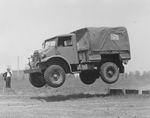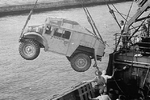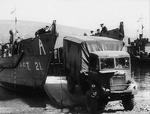![CMP truck file photo [26132] CMP truck file photo [26132]](/images/5796682985567.jpg)
CMP
| Country | Canada |
| Primary Role | Transport |
Contributor: David Stubblebine
ww2dbaseThe Canadian Military Pattern truck (CMP) was not a particular model of truck but was a class of military truck adapted in many forms and made in large numbers during World War II.
ww2dbaseEarly in 1937, the Canadian Department of National Defence invited R. S. McLaughlin of General Motors of Canada Ltd. and the Ford Motor Company of Canada to produce a Canadian prototype of a medium transport truck based on the rugged British Scammell Pioneer heavy hauler. In an unprecedented level of cooperation between the two otherwise rival companies, Ford and Chevrolet created a standardized series of new military vehicles that met British specifications but were designed for production within the Canadian manufacturing processes. Originally they were designated "Department of National Defence" Pattern (DND) but when it became clear these Canadian-built trucks were going to serve in the forces of several other countries, the class of trucks was redesignated "Canadian Military Pattern" (CMP).
ww2dbasePrototypes were subjected to rigorous testing by 1939 and all-out production was underway by 1940. After the British Expeditionary Force was forced to abandon their equipment during the evacuation at Dunkirk in the spring of 1940, there was an urgent need to replace that equipment in the rapidly expanding armed forces of the Commonwealth Nations. The CMP was well suited for this purpose and so production demands went up.
ww2dbaseThe original specifications called for a cab forward design that resulted in a short, flat look to the front that became known as the "Pekinese." The cab design underwent several modifications in the early models before settling on what was called the Type 13 cab. One of the distinctive features of the Type 13 cab was that the two windscreen panels had a reversed slope to reduce reflected sunlight and make the vehicles less visible from the air. For the CMP short wheel base models, the almost cube-like overall shape made it ideal for packing aboard transport ships. For a truck that was destined to travel from Canada to nearly every theater of war, this was a considerable advantage.
ww2dbaseThe versatility of the CMP design is evidenced in the number of variants produced. CMPs were built with carrying capacities of 800 pounds, 1,500 pounds, 2,000 pounds, 2,500 pounds, and 3,000 pounds. The 3,000-pound 4x4 variant was the most numerous. The most common drive system by far was the 4-wheel drive system but there were some 2-wheel drive models and some 3-axle 6-wheel drive models. Based on its versatility, ruggedness, and ease of production, CMPs accounted for nearly two-thirds of all military trucks of all types built in Canada during the war. Nearly 10,000 Canadian-built CMP cab-and-chassis assemblies were also shipped abroad to Britain, Australia, New Zealand, South Africa, India, and Egypt where they were built into an even wider variety of configurations, including several versions of armored cars. In Australian service, CMP trucks were known as the "Blitz."
ww2dbaseCMP trucks were also shipped to the Soviet Union as a portion of Canada's aid to the Allies. During World War II, CMP trucks performed very dependably all around the world; notably in North Africa, Sicily, Italy, the Soviet Front, Burma, the Philippines, France, and Germany. After the war, production of new CMP trucks scaled back but the existing war surplus trucks went on to serve in several of the world's military fleets, as well as many civilian applications, for many productive years to come.
ww2dbaseThe History of the Second World War, the official British history of the war, says the production of the over 410,000 soft-skinned trucks, including trucks of the CMP class, was Canada's most important contribution to the eventual Allied victory. While the Third Canadian Infantry Division at Normandy's Juno Beach might see that question a little differently, the point remains that the CMP class of truck was a very important Canadian contribution to the overall ability of the British Commonwealth of Nations to wage this war.
ww2dbaseSources:
Wikipedia
Maple Leaf Up
Panzerserra Bunker
History of the Second World War (UK)
Last Major Revision: Aug 2016
SPECIFICATIONS
Ford F-30 30cwt
| Machinery | One 239 cu in Ford V8 gasoline engine rated at 95hp |
| Suspension | Wheels, 4x4 |
| Crew | 1 |
| Length | 5.05 m |
| Width | 2.10 m |
| Height | 2.22 m |
| Weight | 2.7 t |
| Speed | 80 km/h |
| Range | 150 km |
Chevrolet C-60S 60cwt
| Machinery | One 216 cu in GMC inline-6 gasoline engine rated at 85hp |
| Suspension | Wheels, 4x4 |
| Crew | 1 |
| Length | 5.05 m |
| Width | 2.10 m |
| Height | 2.28 m |
| Weight | 2.9 t |
| Speed | 80 km/h |
Chevrolet C-60L 60 cwt
| Machinery | One 216 cu in GMC inline-6 gasoline engine rated at 85hp |
| Suspension | Wheels, 4x4 |
| Crew | 1 |
| Length | 5.66 m |
| Width | 2.10 m |
| Height | 2.28 m |
| Weight | 3.0 t |
| Speed | 80 km/h |
Photographs
 |  |  |  |
Você gostou deste artigo ou achou este artigo útil? Se sim, considere nos apoiar no Patreon. Mesmo USD $1 por mês já vai longe! Obrigado. Por favor, ajude-nos a espalhar a palavra: Fique atualizado com WW2DB: |
Visitor Submitted Comments
All visitor submitted comments are opinions of those making the submissions and do not reflect views of WW2DB.
- » Wreck of M-49 Found (10 Apr 2025)
- » Japanese Emperor Visited Iwoto (Iwo Jima) (8 Apr 2025)
- » Race, Holocaust, and African-American WW2 Histories Removed from the US Naval Academy Library (7 Apr 2025)
- » US Government Plans to Purge WW2 Information (17 Mar 2025)
- » Ver todas as notícias
- » 1,167 biographies
- » 337 events
- » 44,606 timeline entries
- » 1,243 ships
- » 350 aircraft models
- » 207 vehicle models
- » 376 weapon models
- » 123 historical documents
- » 261 facilities
- » 470 book reviews
- » 28,505 photos
- » 365 maps
Joachim von Ribbentrop, German Foreign Minister, Aug 1939
Por favor, considere nos apoiar no Patreon. Mesmo R$1 por mês já faz uma grande diferença. Obrigado!
Ou, por favor, nos apoie adquirindo alguns produtos do WW2DB na TeeSpring. Obrigado!
12 Jul 2020 12:26:31 AM
I was born in 1945 just bought a Chevrolet blitz going to put it on the road